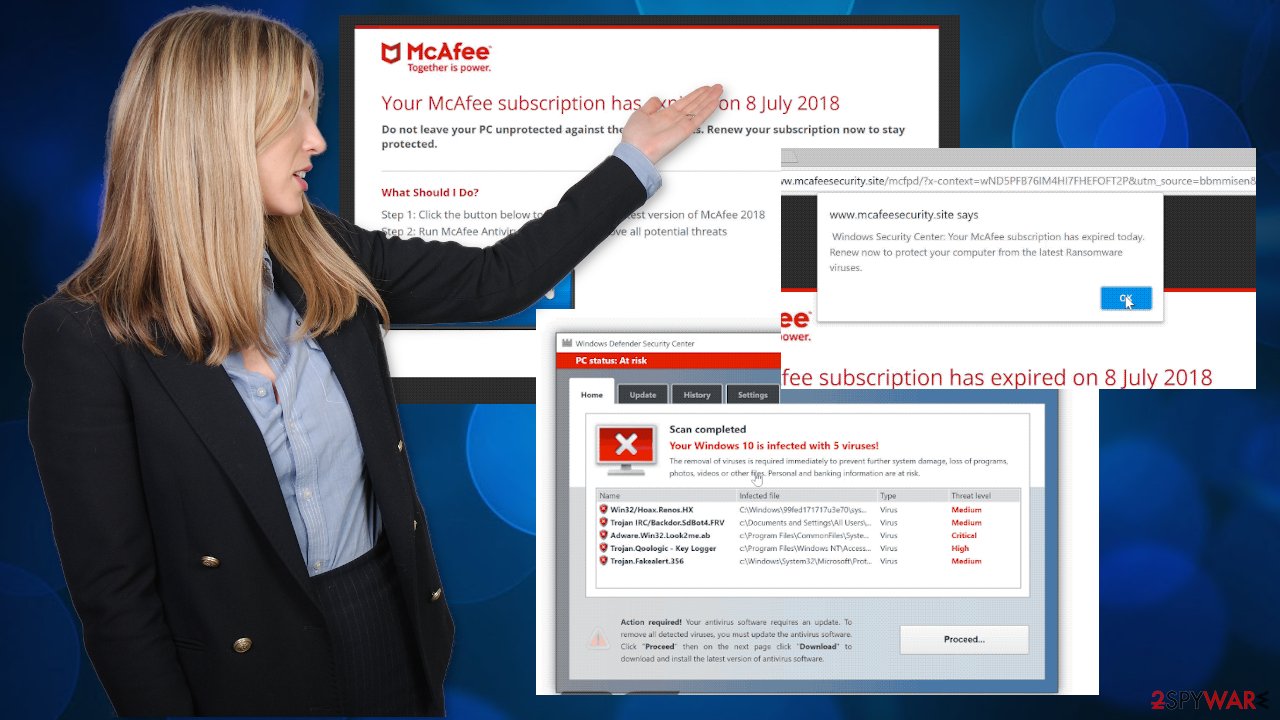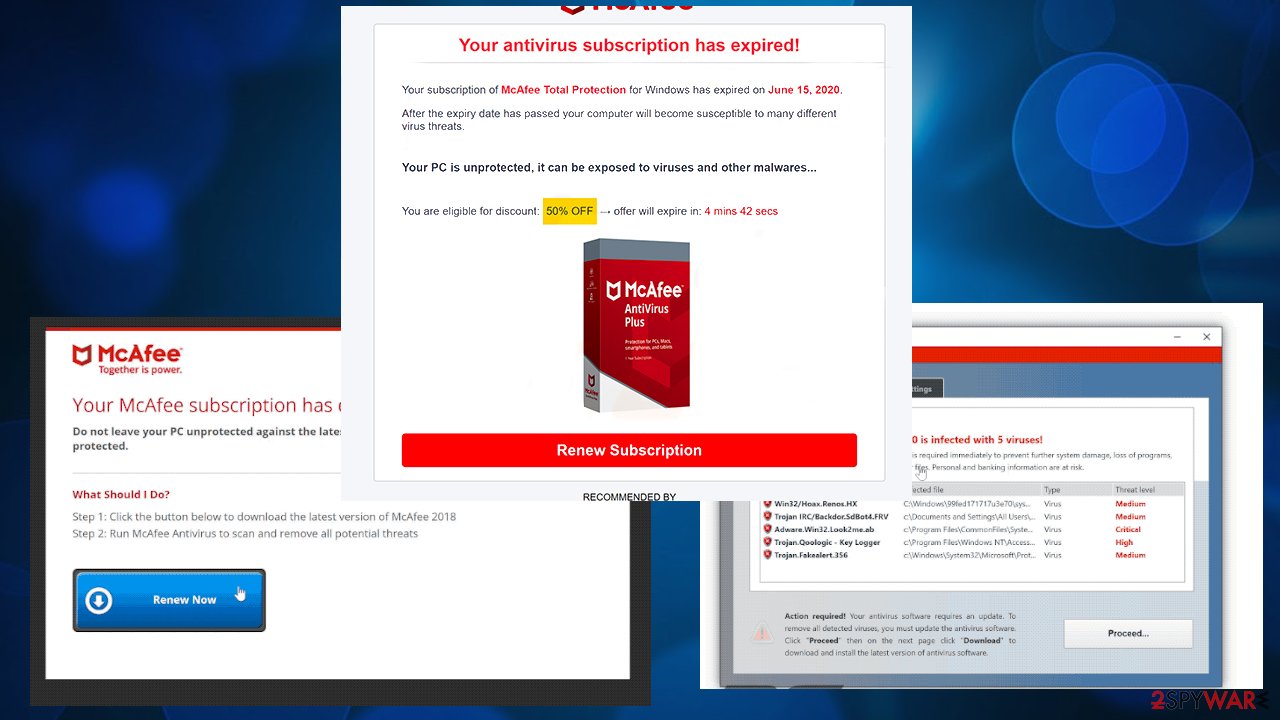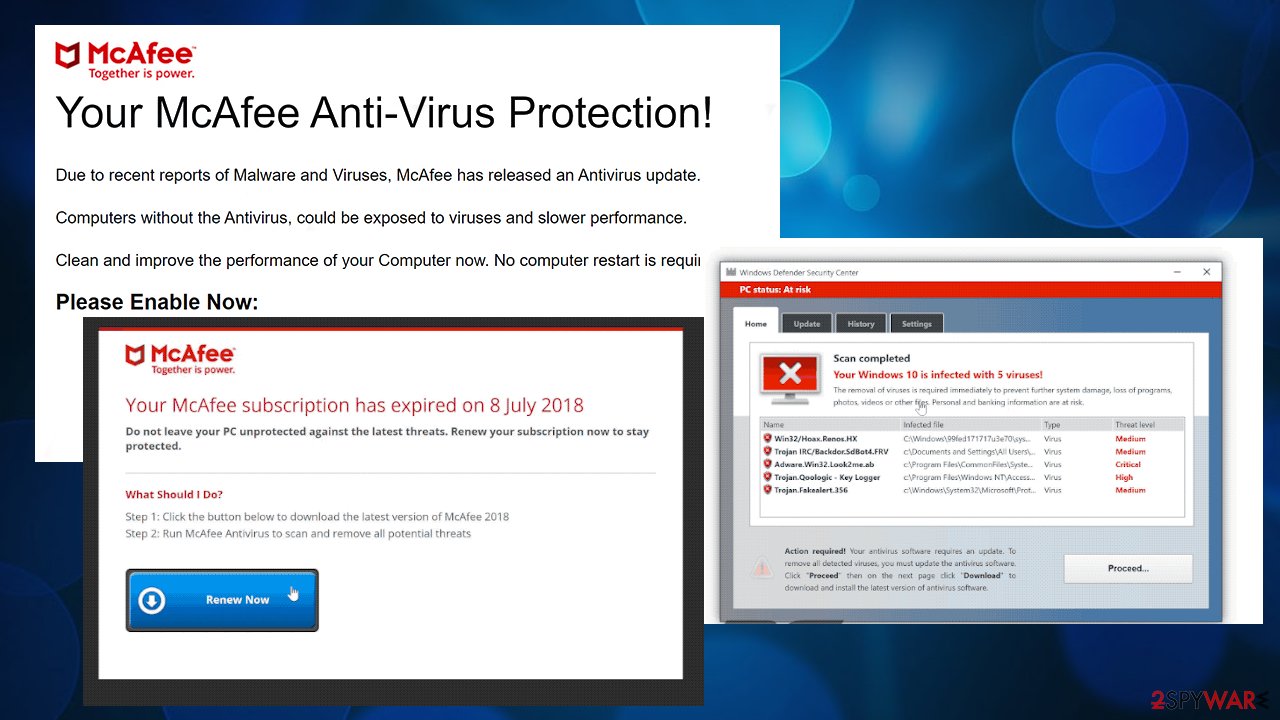Your McAfee Subscription Has Expired scam (virus) - Free Instructions
Your McAfee Subscription Has Expired scam Removal Guide
What is Your McAfee Subscription Has Expired scam?
Your McAfee Subscription Has Expired – scam message that claims about non-existent issues and can redirect to various deceptive sites

Your McAfee Subscription Has Expired is a scam[1] message which is typically initiated by adware. The fake error announces that the McAfee antivirus license has expired and needs to be renewed in order to protect your machine. To do that, you are prompted to click “Renew Now.” Nevertheless, it is only a dubious way to trick you into paying for bogus software or entering personal details that can be used for illegal activities. The false alert might pop up in Google Chrome, Mozilla Firefox, or any other browser, but you should never proceed as it is just a scam and should be ignored.
The deceptive pop-up states about the renewal of a subscription. Some of the messages offer the one-year or 3-year McAfee package for a discounted amount, but users[2] report that these pop-ups lead to losses of significantly larger amounts of money. The installation of the paid tool, in most cases, is also not possible, so people end up paying for nothing. This is the main goal of such scammy messages – to gain profits by tricking people into believing these security issue claims.
The potentially unwanted program can trigger the delivery of various shady content, redirect to dangerous sites and lead to information tracking activities. There might be an issue when you try to eliminate the PUP – the root cause of all the pop-up scam messages. You can find the proper instructions below the article and avoid further damage that the social engineering tactics and PUP infiltration methods can result in.
| Name | Your McAfee Subscription Has Expired |
|---|---|
| Type | Adware/scam |
| main targets | Windows OS, Google Chrome, Mozilla Firefox, Internet Explorer, Safari web browsers |
| Symptoms | The pop-up error shows up, various annoying ads overload your infected browser |
| Distribution | The virus is using other regular software to get inside undetected. It can also come from dubious web pages |
| Avoiding methods | Download programs only from trusted sources and pick Advanced installation mode, be careful while browsing the Web, install an antivirus for better protection. |
| Removal | Reset your web browsers, uninstall apps that you cannot remember installing, scan the system with the anti-virus software |
| Recovery | Use FortectIntego to fix virus damage after the virus termination process |
The personal data you have entered might be used for gaining revenue for the adware authors. You need to be careful if you encounter the Your McAfee Subscription Has Expired virus. If you did not permit the antivirus “renewing” process, leave the scam site immediately in order to avoid personal data misuse.
The message users can encounter states the following or similar alerts:
McAfee Security Renewal Notice
Subscription may have expired
After expiration, your computer may be susceptible to viruses and malware
Your McAfee May Have Expired!
Renew Now For 2020
or
Your McAfee subscription has expired today
Do not leave your PC unprotected against the latest threats. Renew your subscription now to stay protected.
What Should I Do?
Step 1: Click the button below to download the latest version of Mcafee 2018Step 2: Run Mcafee to scan and remove all potential threats
Renew Now
As you can see, the McAfee Subscription scam tries to trick users into the proceeding. What is more, the fake pop-up displays the IP address, OS type, Internet Provider, and browser type to make the message look more trustworthy. Cybercrooks can read that information easily if they enter a compromised site.

Aside from fake messages, you can also encounter numerous pop-ups, pop-unders, coupons, banners, deals, in-text links, and auto-play video ads, as it is typical of adware programs. The advertisement can be initiated at any time when you are browsing the web.
Additionally, such PUP might collect various browsing activity-related details[3]:
- IP addresses;
- Locations;
- Bookmarks;
- Search queries;
- Pages viewed;
- Etc.
Your McAfee Subscription Has Expired pop-up as other scams most often aim to get users' attention and lead to download or purchase of the useless programs. Unfortunately, rogue application installs are less damaging than the installation of the paid tool that does nothing that is supposed to.

To protect various important information and stop hazardous activity, you need to remove the virus from your computer and clear your browsers. Additionally, use FortectIntego to restore your system to its primary state and recover from virus damage.
If you did not succeed in avoiding such dubious programs, perform the Your McAfee Subscription Has Expired removal as soon as you discover its symptoms which might include various annoying advertisements, browser struggles, fake scam pop-ups, and similar. You should get rid of every app that you can't remember installing.
Do not forget to rely on proper tools for such intruders. You can remove the malware that causes these scam messages. The best option for that – antivirus engines, programs like SpyHunter 5Combo Cleaner or Malwarebytes that can run a proper scan on the system to gather all the traces of this virus.

Avoid adware and other PUPs
According to NoVirus.uk[4] specialists, numerous users get their computers infected with various dubious programs without even noticing it. Such PUPs as adware might be distributed through other regular programs as an additional component, or can be accidentally activated if you have clicked on a suspicious-looking hyperlink.
To avoid damaging consequences, always be careful while surfing the Internet. Do not enter any dubious websites or links. If you did so – eliminate them immediately and perform a system scan with an antivirus due to ensure that no harmful components infiltrated the system.
Additionally, download your software only from trusted sites, avoid using secondary installers as they might contain harmful content within them. Furthermore, when installing freeware and shareware, always pick Advanced or Custom installation settings, so you have the opportunity to remove all the additional programs before the installation procedure is complete.
Get rid of the virus from your PC quickly to stop scam messages
To remove Your McAfee Subscription Has Expired and all adware-related components you need to go through your entire system and recently installed apps. Eliminate all browser extensions, apps, and plug-ins that you can't remember installing. Additionally, reset the affected web browser or browsers. This can be performed with the help of our instructions below this article.
The message allegedly states about McAfee antivirus suite subscription issues and encourages people to renew the license immediately. However, the message is a part of the scam campaign and is not related to any real problems with your device. You might end up with a cyber infection instead of the antivirus tool subscription and damage your device that way.
It is important to clear any potential intruders right away. Of course, you can carry out the Your McAfee Subscription Has Expired removal by downloading and installing an anti-malware tool. It will let you get rid of the cyber threat in just a few minutes. Tools that are provided below will also help you fix virus damage.
You may remove virus damage with a help of FortectIntego. SpyHunter 5Combo Cleaner and Malwarebytes are recommended to detect potentially unwanted programs and viruses with all their files and registry entries that are related to them.
Getting rid of Your McAfee Subscription Has Expired scam. Follow these steps
Uninstall from Windows
Instructions for Windows 10/8 machines:
- Enter Control Panel into Windows search box and hit Enter or click on the search result.
- Under Programs, select Uninstall a program.

- From the list, find the entry of the suspicious program.
- Right-click on the application and select Uninstall.
- If User Account Control shows up, click Yes.
- Wait till uninstallation process is complete and click OK.

If you are Windows 7/XP user, proceed with the following instructions:
- Click on Windows Start > Control Panel located on the right pane (if you are Windows XP user, click on Add/Remove Programs).
- In Control Panel, select Programs > Uninstall a program.

- Pick the unwanted application by clicking on it once.
- At the top, click Uninstall/Change.
- In the confirmation prompt, pick Yes.
- Click OK once the removal process is finished.
Delete from macOS
Remove items from Applications folder:
- From the menu bar, select Go > Applications.
- In the Applications folder, look for all related entries.
- Click on the app and drag it to Trash (or right-click and pick Move to Trash)

To fully remove an unwanted app, you need to access Application Support, LaunchAgents, and LaunchDaemons folders and delete relevant files:
- Select Go > Go to Folder.
- Enter /Library/Application Support and click Go or press Enter.
- In the Application Support folder, look for any dubious entries and then delete them.
- Now enter /Library/LaunchAgents and /Library/LaunchDaemons folders the same way and terminate all the related .plist files.

Remove from Microsoft Edge
Delete unwanted extensions from MS Edge:
- Select Menu (three horizontal dots at the top-right of the browser window) and pick Extensions.
- From the list, pick the extension and click on the Gear icon.
- Click on Uninstall at the bottom.

Clear cookies and other browser data:
- Click on the Menu (three horizontal dots at the top-right of the browser window) and select Privacy & security.
- Under Clear browsing data, pick Choose what to clear.
- Select everything (apart from passwords, although you might want to include Media licenses as well, if applicable) and click on Clear.

Restore new tab and homepage settings:
- Click the menu icon and choose Settings.
- Then find On startup section.
- Click Disable if you found any suspicious domain.
Reset MS Edge if the above steps did not work:
- Press on Ctrl + Shift + Esc to open Task Manager.
- Click on More details arrow at the bottom of the window.
- Select Details tab.
- Now scroll down and locate every entry with Microsoft Edge name in it. Right-click on each of them and select End Task to stop MS Edge from running.

If this solution failed to help you, you need to use an advanced Edge reset method. Note that you need to backup your data before proceeding.
- Find the following folder on your computer: C:\\Users\\%username%\\AppData\\Local\\Packages\\Microsoft.MicrosoftEdge_8wekyb3d8bbwe.
- Press Ctrl + A on your keyboard to select all folders.
- Right-click on them and pick Delete

- Now right-click on the Start button and pick Windows PowerShell (Admin).
- When the new window opens, copy and paste the following command, and then press Enter:
Get-AppXPackage -AllUsers -Name Microsoft.MicrosoftEdge | Foreach {Add-AppxPackage -DisableDevelopmentMode -Register “$($_.InstallLocation)\\AppXManifest.xml” -Verbose

Instructions for Chromium-based Edge
Delete extensions from MS Edge (Chromium):
- Open Edge and click select Settings > Extensions.
- Delete unwanted extensions by clicking Remove.

Clear cache and site data:
- Click on Menu and go to Settings.
- Select Privacy, search and services.
- Under Clear browsing data, pick Choose what to clear.
- Under Time range, pick All time.
- Select Clear now.

Reset Chromium-based MS Edge:
- Click on Menu and select Settings.
- On the left side, pick Reset settings.
- Select Restore settings to their default values.
- Confirm with Reset.

Remove from Mozilla Firefox (FF)
Remove dangerous extensions:
- Open Mozilla Firefox browser and click on the Menu (three horizontal lines at the top-right of the window).
- Select Add-ons.
- In here, select unwanted plugin and click Remove.

Reset the homepage:
- Click three horizontal lines at the top right corner to open the menu.
- Choose Options.
- Under Home options, enter your preferred site that will open every time you newly open the Mozilla Firefox.
Clear cookies and site data:
- Click Menu and pick Settings.
- Go to Privacy & Security section.
- Scroll down to locate Cookies and Site Data.
- Click on Clear Data…
- Select Cookies and Site Data, as well as Cached Web Content and press Clear.

Reset Mozilla Firefox
If clearing the browser as explained above did not help, reset Mozilla Firefox:
- Open Mozilla Firefox browser and click the Menu.
- Go to Help and then choose Troubleshooting Information.

- Under Give Firefox a tune up section, click on Refresh Firefox…
- Once the pop-up shows up, confirm the action by pressing on Refresh Firefox.

Remove from Google Chrome
Delete malicious extensions from Google Chrome:
- Open Google Chrome, click on the Menu (three vertical dots at the top-right corner) and select More tools > Extensions.
- In the newly opened window, you will see all the installed extensions. Uninstall all the suspicious plugins that might be related to the unwanted program by clicking Remove.

Clear cache and web data from Chrome:
- Click on Menu and pick Settings.
- Under Privacy and security, select Clear browsing data.
- Select Browsing history, Cookies and other site data, as well as Cached images and files.
- Click Clear data.

Change your homepage:
- Click menu and choose Settings.
- Look for a suspicious site in the On startup section.
- Click on Open a specific or set of pages and click on three dots to find the Remove option.
Reset Google Chrome:
If the previous methods did not help you, reset Google Chrome to eliminate all the unwanted components:
- Click on Menu and select Settings.
- In the Settings, scroll down and click Advanced.
- Scroll down and locate Reset and clean up section.
- Now click Restore settings to their original defaults.
- Confirm with Reset settings.

Delete from Safari
Remove unwanted extensions from Safari:
- Click Safari > Preferences…
- In the new window, pick Extensions.
- Select the unwanted extension and select Uninstall.

Clear cookies and other website data from Safari:
- Click Safari > Clear History…
- From the drop-down menu under Clear, pick all history.
- Confirm with Clear History.

Reset Safari if the above-mentioned steps did not help you:
- Click Safari > Preferences…
- Go to Advanced tab.
- Tick the Show Develop menu in menu bar.
- From the menu bar, click Develop, and then select Empty Caches.

After uninstalling this potentially unwanted program (PUP) and fixing each of your web browsers, we recommend you to scan your PC system with a reputable anti-spyware. This will help you to get rid of Your McAfee Subscription Has Expired scam registry traces and will also identify related parasites or possible malware infections on your computer. For that you can use our top-rated malware remover: FortectIntego, SpyHunter 5Combo Cleaner or Malwarebytes.
How to prevent from getting adware
Access your website securely from any location
When you work on the domain, site, blog, or different project that requires constant management, content creation, or coding, you may need to connect to the server and content management service more often. The best solution for creating a tighter network could be a dedicated/fixed IP address.
If you make your IP address static and set to your device, you can connect to the CMS from any location and do not create any additional issues for the server or network manager that needs to monitor connections and activities. VPN software providers like Private Internet Access can help you with such settings and offer the option to control the online reputation and manage projects easily from any part of the world.
Recover files after data-affecting malware attacks
While much of the data can be accidentally deleted due to various reasons, malware is one of the main culprits that can cause loss of pictures, documents, videos, and other important files. More serious malware infections lead to significant data loss when your documents, system files, and images get encrypted. In particular, ransomware is is a type of malware that focuses on such functions, so your files become useless without an ability to access them.
Even though there is little to no possibility to recover after file-locking threats, some applications have features for data recovery in the system. In some cases, Data Recovery Pro can also help to recover at least some portion of your data after data-locking virus infection or general cyber infection.
- ^ What is Scam?. Free Internet Security.
- ^ It is a scam of renewal of MaAfee of US149 (3 years) which end up charging almost US400. Answers. Microsoft community forum.
- ^ Denise Ferreira. How Does Adware Hurt My Computer?. Top Ten Reviews.
- ^ NoVirus. IT experts. Security problem solving.























